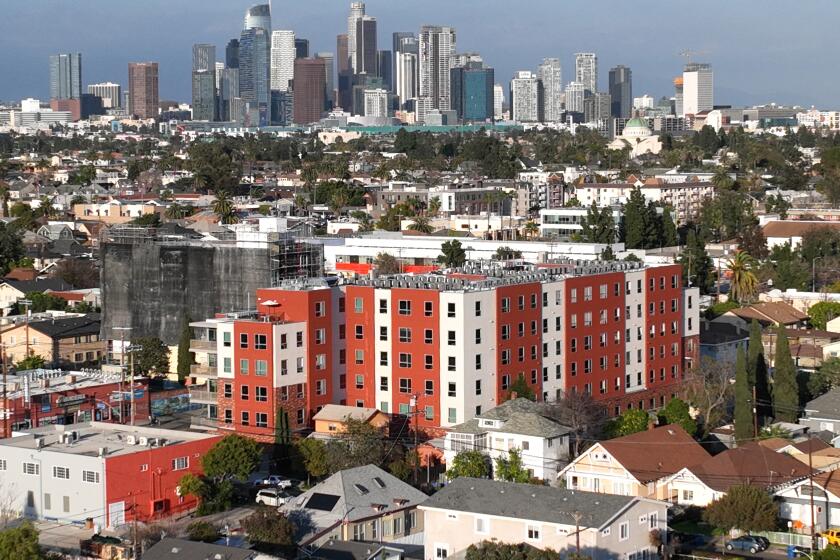A part of the city, yet apart from it too

- Share via
Background
In 1918, while partners Burton Green, Max Whittier and Charles Canfield of the Rodeo Land & Water Co. were busy building estates in Beverly Hills, Canfield’s son-in-law looked elsewhere. Jake Danziger purchased the northwestern slice of the Wolfskill Ranch, barely a mile west of the Beverly Hills city limits. On his 600-acre estate, Danziger constructed a Spanish-style mansion, which included a panoramic view from downtown Los Angeles to Catalina Island.Developer Alfonzo Bell purchased the Danziger estate in 1922, amassing a total of 4,500 acres. Naming his development Bel-Air, Bell hired engineer Wilkie Woodward to plan the subdivision. Landscape architect Aurele Vermuleon was hired to coordinate the plantings.
Underground utilities were installed, and estates of 1 acre and larger were created, as well as 50 miles of bridle paths. Huge iron gates still mark an impressive entry to Bel-Air just north of the intersection of Sunset Boulevard and Bel Air Road.
Bel-Air officially opened in October 1922. Uniformed guards at the gate, a first for any local community, checked in visitors. Deed restrictions required land purchasers to spend a minimum of $20,000 on home construction.
Social scene
The Bel-Air Country Club, built in 1927 as part of the original development, showcases the natural beauty of the area while providing a meeting place for residents. The Spanish-style clubhouse, along with tennis courts and an 18-hole golf course, remain popular today. Membership is not required of residents, nor is Bel-Air residency required for membership in the club.Midcentury changes
Fueled by postwar demand, the upper reaches of Bel-Air became popular for development in the 1950s. Lots in the hills and to the west were usually less than an acre, and the homes were smaller than the earlier ones. With no architectural review, homes were built in a wide variety of styles and price ranges.Fire on the mountain
Living in the hills has its hazards. A brush fire in 1961 ravaged the hillsides and destroyed 484 residences. More than 75% of the destroyed structures had wood-shingle or shake roofing, according to the Los Angeles Fire Department, and 70% were within 50 feet of natural vegetation. After the fire, more stringent safety standards prohibited replacement wood or combustible roofing on all new construction and required annual brush clearance.Insider’s view
Sarah Austerlitz moved her family of five from Hancock Park to Bel-Air more than a decade ago.“We love being part of the city and apart from the city all at the same time,” she said. Their classic Paul Williams-designed home, built behind gates in 1932, has eight bedrooms and five baths and is typical of the original estates of Bel-Air.
“We feel private and secluded,” she said, “yet to reenter the world we simply pull out of our driveway onto Sunset Boulevard.”
Drawing card
The large estates north of Sunset mirror those in adjacent Beverly Hills, but there is less traffic and congestion from tour buses and outsiders. Beverly Glen Boulevard borders the community to the east and Sepulveda Boulevard to the west.Good news, bad news
Rising real estate values have inspired increased residential development. With buildable lots scarce, sizable concrete walls have been erected on several hillsides.On the market
Of the about 50 Bel-Air homes for sale, eight are listed in excess of $10 million. The lowest-priced listing, at $1,095,000, is a 2,000-square-foot home built in 1980 with three bedrooms and 3 1/2 baths. Homes for lease range from one built in the 1950s for $4,250 a month to a five-bedroom, seven-bath estate in lower Bel-Air for $25,000 a month.Report card
Bel-Air residents are served by the L.A. Unified School District. Warner Avenue Elementary scored 948 out of a potential 1,000 on the 2004 Academic Performance Index. Emerson Middle School scored 650, with University High reporting 639.Historical values
Residential resales:Year...Median Price
1990...$942,0001995...$750,000
2000...$1,187,500
2003...$1,240,000
2004...$1,525,000
Sources: DataQuick Information Systems, https://www.lafire.com , https://www.losangelesalmanac.com , https://www.hotelbelair.com , https://www.golfcourse.com , https://www.themls.com , Bel-Air Country Club, https://www.lapdonline.org , “The Estates of Beverly Hills” by Charles Lockwood and Jeff Hyland.
More to Read
Sign up for Essential California
The most important California stories and recommendations in your inbox every morning.
You may occasionally receive promotional content from the Los Angeles Times.






